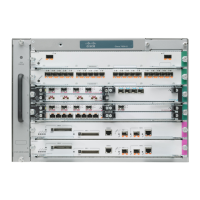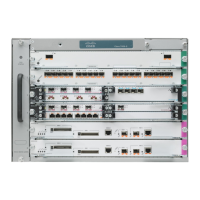4-7
Cisco 7206 Installation and Configuration Guide
OL-5102-02
Chapter 4 Performing a Basic Configuration of the Cisco 7206
Configuring the Cisco 7206
Configure IPX on this interface? [no]: yes
IPX network number [2]:
Step 3 If you will be using AppleTalk on the interface, enter yes. Enter yes to configure for extended AppleTalk
networks, and then enter the cable range number. Enter the zone name and any other additional zones
that are associated with your local zone:
Configure AppleTalk on this interface? [no]: yes
Extended AppleTalk network? [no]: yes
AppleTalk starting cable range [0]:
Step 4 Save your settings to NVRAM. (Refer to the “Saving Your Settings to NVRAM” section on page 4-10.)
Note If additional Ethernet interfaces are available in your system, you are prompted for their configurations
as well.
Configuring Synchronous Serial Interfaces
Synchronous serial interfaces are configured to allow connection to WANs through a CSU/DSU.
Complete the following steps to configure the serial ports:
Step 1 To configure serial port 0, enter yes:
Configuring interface Serial1/0:
Is this interface in use? [no]: yes
Step 2 Determine which protocols you want on the synchronous serial interface and enter the appropriate
responses:
Configure IP unnumbered on this interface? [no]:
IP address for this interface: 10.1.1.20
Number of bits in subnet field [0]:
Class A network is 1.0.0.0, 0 subnet bits; mask is 255.0.0.0
Configure IPX on this interface? [no]: yes
IPX network number [2]:
Configure AppleTalk on this interface? [no]: yes
Extended AppleTalk network? [no]:
AppleTalk network number [1]:
Step 3 Save your settings to NVRAM. (Refer to the “Saving Your Settings to NVRAM” section on page 4-10.)
Note If additional synchronous serial interfaces are available in your system, you are prompted for their
configuration as well.

